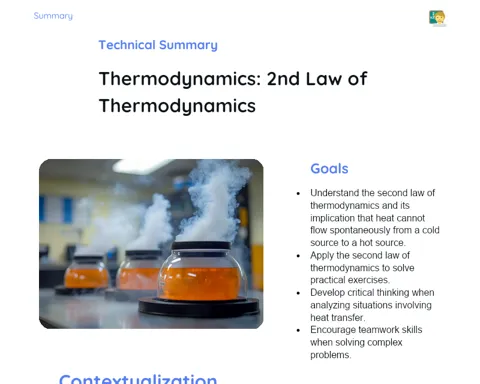TOPICS - Kinematics: Acceleration of Uniformly Varied Circular Motion
Keywords
- Circular Motion
- Centripetal Acceleration
- Tangential Acceleration
- Angular Velocity
- Uniformly Varied
- Curve Radius
Key Questions
- What characterizes Uniformly Varied Circular Motion (UVCM)?
- How does tangential acceleration affect velocity in UVCM?
- What is the relationship between tangential velocity and centripetal acceleration?
- How does the radius of the trajectory influence centripetal acceleration?
Crucial Topics
- Differentiation between Uniform Circular Motion (UCM) and UVCM.
- Understanding the concept of acceleration in circular motion.
- Identification of acceleration components in circular motions: tangential and centripetal.
Specifics - Formulas
- Centripetal Acceleration (ac):
a_c = v² / Rwhere v is the tangential velocity and R is the curve radius. - Tangential Acceleration (at):
a_t = ∆v / ∆twhere ∆v is the variation of tangential velocity and ∆t is the time interval during the variation. - Relation between angular velocity (ω) and tangential (v):
v = ω * R. - Calculation of Angular Velocity (ω):
ω = ∆θ / ∆twhere ∆θ is the variation of the angle described by the radius vector and ∆t is the time interval.
NOTES - Acceleration in Uniformly Varied Circular Motion
Key Terms
- Circular Motion: Displacement of an object along a circular trajectory.
- Centripetal Acceleration: Acceleration that keeps an object in motion along a circular trajectory, always directed towards the center of it.
- Tangential Acceleration: Acceleration that occurs in the direction tangent to the trajectory, resulting in the variation of the object's speed module.
- Angular Velocity: Rate of change of the angle described by the radius vector over time.
- Uniformly Varied: Motion where acceleration is constant in magnitude, direction, and sense.
- Curve Radius: Distance from the center of the circular trajectory to a point on the trajectory.
Main Ideas and Concepts
- Difference between UCM and UVCM: While UCM has constant velocity, UVCM has variable velocity due to the presence of tangential acceleration.
- Impact of Tangential Acceleration: Causes changes in the tangential velocity module as the object travels along the circular trajectory.
- Velocity-Acceleration Relationship: Centripetal acceleration depends on the square of the tangential velocity; the higher the velocity, the greater the centripetal acceleration needed to maintain circular motion.
- Influence of Radius: The radius of the trajectory is inversely proportional to centripetal acceleration; a larger radius results in lower centripetal acceleration for the same tangential velocity.
Topic Contents
- Centripetal Acceleration (ac): Product of the square of the tangential velocity by the inverse of the radius of the circular trajectory. Essential to understand the 'force' acting on the object, keeping it in circular motion.
- Tangential Acceleration (at): Represents the rate of change of the tangential velocity module over time. Connected to the object's ability to 'accelerate' or 'decelerate' along the curve.
- Angular Velocity (ω): Connection between linear and angular motions in UVCM; useful for calculating tangential velocity from an angular perspective.
Examples and Cases
- Accelerating Carousel: Imagine a carousel that starts to accelerate, its tangential velocity increases, and therefore, the tangential acceleration is positive.
- Calculation: If its velocity increases from 0 to 10 m/s in 5 seconds, the tangential acceleration is
a_t = (10 m/s - 0 m/s) / 5 s = 2 m/s².
- Calculation: If its velocity increases from 0 to 10 m/s in 5 seconds, the tangential acceleration is
- Vehicle on a Curve: A vehicle takes a curve with a radius of 50 meters at a constant speed of 20 m/s.
- Calculation: The centripetal acceleration is
a_c = (20 m/s)² / 50 m = 8 m/s², always pointing towards the center of the curve.
- Calculation: The centripetal acceleration is
SUMMARY - Kinematics: Acceleration of Uniformly Varied Circular Motion
Summary of the most relevant points
- Centripetal Acceleration keeps the body in circular motion, directing it towards the center of the trajectory.
- Tangential Acceleration is responsible for the variation of the speed module in UVCM, causing acceleration or deceleration of the body.
- Angular Velocity is directly related to tangential velocity and provides an angular perspective of the motion.
- Influence of Radius is inverse to centripetal acceleration, demonstrating that the larger the radius, the lower the centripetal acceleration required, keeping the tangential velocity constant.
Conclusions
- Understanding the relationship between tangential velocity and centripetal acceleration is crucial (
a_c = v² / R); it allows calculating the 'force' acting on the body in circular motion. - Calculating tangential acceleration (
a_t = ∆v / ∆t) is essential to understand the dynamics of UVCM, including how the velocity variation affects the trajectory. - Identifying when a motion is uniform and when it is varied is important for the correct application of formulas and concepts.
- The applicability of these concepts is evident in real contexts, such as vehicles on curves or objects in accelerated rotation, reinforcing the relevance of Kinematics in understanding everyday movements.



